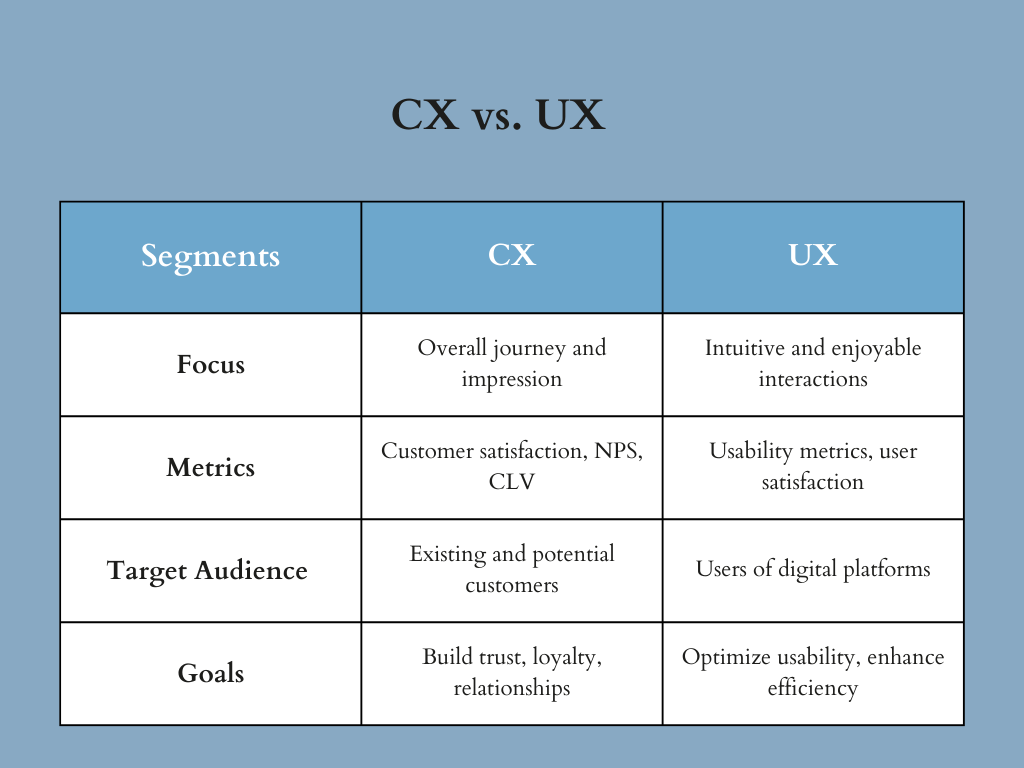Customer Experience
Customer Experience vs. User Experience: Key Differences and Examples
Article written by Kate Williams
Content Marketer at SurveySparrow
9 min read
19 September 2025

Have you ever had a memorable encounter with a brand that left you feeling valued and satisfied? Or perhaps you’ve used a digital platform that was so intuitive and seamless that it made your life easier. These exceptional experiences are the result of careful attention to two crucial elements: customer experience (CX) and user experience (UX).
Then again, have you ever pondered the differences between CX and UX? These two terms often intertwine in discussions about crafting unforgettable interactions with brands and digital platforms. If you’re also one of them, worry not! Let’s dive into the realm of customer experience vs. user experience.
What is Customer Experience?
Customer experience (CX) encompasses every interaction and touchpoint a customer has with a brand throughout their journey. It includes pre-purchase interactions, the purchase itself, and post-purchase support. CX focuses on the emotional aspect of the customer’s journey, aiming to build trust, loyalty, and satisfaction. A positive customer experience ensures customers feel valued, appreciated, and understood, leading to long-term relationships.
What’s the goal?
The goal of CX is to make customers feel valued, appreciated and understood. It’s all about building trust, loyalty, and long-term relationships. Think about the last time you had a phenomenal experience with a company. Maybe the support team went above and beyond to solve your issue, or perhaps the packaging of your order made you feel like you were opening a gift. Those little moments leave a lasting impression and make you want to shout from the rooftops about the brand.
What is User Experience?
User experience (UX), on the other hand, concentrates on the design and usability of a product or service. It encompasses the user’s interactions, perceptions, and emotions while engaging with a digital platform, website, or application. UX aims to make the user’s journey intuitive, efficient, and enjoyable, focusing on aspects such as navigation, ease of use, and visual design.
Imagine opening a mobile app and feeling instantly at ease. The interface flows naturally, the buttons are right where you expect them to be, and the visuals are eye-catching. It’s like the app knows you and your needs even before you do! That’s the power of UX at play. It’s all about removing friction, simplifying complex tasks, and providing a delightful experience that keeps users returning for more.
Customer Experience vs User Experience
While CX and UX share similarities, they have distinct foci and scopes. The primary difference lies in their objectives and the entities they prioritize—customers and users, respectively. CX emphasizes the customer’s journey and overall impression of a brand, whereas UX concentrates on designing enjoyable and efficient interactions with a product or service.
CX involves various touch points beyond the digital realm, encompassing both online and offline interactions. It addresses emotions, perceptions, and satisfaction at every stage of the customer’s journey. On the other hand, UX refers explicitly to the user’s experience with digital platforms and aims to optimize usability, functionality, and visual design.
Let’s take a deeper look at the differences.

1. Focus and Daily Responsibilities:
- CX emphasizes the overall journey and impression of the customer, both online and offline. It focuses on emotional connections, trust-building, and providing exceptional experiences across all touchpoints.
- UX concentrates on designing intuitive and enjoyable interactions with digital products or services. It involves creating user-friendly interfaces, optimizing usability, and enhancing visual design to ensure a seamless and delightful user experience.
2. Metrics:
- CX is measured through metrics such as customer satisfaction, Net Promoter Score (NPS), Customer Effort Score (CES), and Customer Lifetime Value (CLV). These metrics gauge customer perceptions, loyalty, and the overall success of CX initiatives.
- UX is evaluated using usability metrics, including task success rate, error rate, time on task, and user satisfaction. These metrics assess the effectiveness, efficiency, and satisfaction of users when engaging with digital interfaces.
3. Target Audience:
- CX primarily focuses on existing and potential customers of a brand. It encompasses all individuals who interact with the brand, both online and offline, throughout their customer journey.
- UX centers around users who engage with digital platforms, websites, or applications. The target audience includes individuals who interact with digital interfaces and require a seamless and intuitive user experience.
4. Goals and Objectives:
- The primary goal of CX is to build trust, foster loyalty, and establish long-term customer relationships. CX aims to create memorable experiences that leave a positive impression and drive customer advocacy.
- UX aims to optimize usability, enhance efficiency, and provide enjoyable interactions with digital products or services. The objective is to design interfaces that are intuitive, visually appealing, and meet user needs, ultimately driving user satisfaction and engagement.
Why differentiate between CX and UX?
Are you wondering, why care about the difference between CX and UX?
Well, you should because:
- Understanding this distinction is crucial for businesses that strive to win over customers in today’s competitive landscape.
- By recognizing the unique objectives of each discipline, companies can create comprehensive strategies that cater to both aspects.
- When CX and UX are seamlessly integrated, something magical happens. Customers experience consistent and satisfying interactions across all touch points.
- It’s like they’re riding a smooth rollercoaster of delightful experiences, which leaves them wanting more. This leads to increased customer loyalty, positive word-of-mouth recommendations, and a competitive edge in the market.
How CX and UX Work Together
While we are talking about the key differences between CX and UX, it is also important to see how well they work together.
CX and UX are not isolated elements; they work hand in hand to shape the overall experience that customers and users have with a brand. Let’s dive into how CX and UX collaborate and complement each other:
Customer Insights Drive User Experience
- CX teams play a crucial role in gathering customer insights through surveys, interviews, and data analysis. These insights provide UX teams with a deep understanding of user needs, pain points, and preferences.
- By sharing this valuable information, CX teams empower UX teams to design user experiences that align with customer expectations.
UX Enhances the Overall Customer Experience
- While CX focuses on the holistic customer journey, UX plays a pivotal role in shaping the digital interactions within that journey.
- A seamless and intuitive user experience enhances the overall customer experience. When users find a website or application easy to navigate, visually appealing, and efficient, it positively impacts their perception of the brand and contributes to a positive CX.
Collaboration and Iterative Feedback Loop
- Effective collaboration tools for CX and UX teams is essential for creating cohesive and delightful experiences. CX teams provide UX teams with customer feedback, insights, and journey mapping.
- UX teams, in turn, incorporate these insights into their design process, creating interfaces that address pain points, optimize usability, and align with customer expectations.
- This iterative feedback loop ensures continuous improvement and alignment with customer needs.
Consistency across Channels and Touch points
- CX and UX collaboration ensures consistency across channels and touch points. A seamless transition between different touch points, both online and offline, creates a cohesive and integrated experience for customers.
- The design elements, visual language, and overall feel remain consistent, reinforcing the brand identity and strengthening the overall customer experience.
Data-Driven Decision Making
- Both CX and UX teams rely on data to inform their decision-making processes. CX teams analyze customer data to identify trends and patterns, while UX teams conduct usability tests and analyze user behavior data.
- This data-driven approach ensures that decisions related to CX and UX are based on empirical evidence, resulting in more effective and impactful experiences.
What Are the Tasks Involved? CX and UX Examples
Now, let’s dive into the tasks involved in both customer experience (CX) and user experience (UX). These examples will shed light on the specific responsibilities undertaken by CX and UX teams to create remarkable experiences.
CX Tasks
- Collecting customer feedback through surveys, interviews, and social media monitoring
- Analyzing customer data to identify trends, preferences, and pain points
- Mapping the customer journey and identifying areas for improvement
- Developing customer-centric strategies and personalized communication
UX Tasks
- Conducting user research to understand target users, their needs, and behaviors
- Creating wireframes, prototypes, and conducting usability testing
- Designing intuitive and visually appealing interfaces
- Optimizing website or application performance for a seamless user experience
These tasks exemplify how CX and UX teams collaborate to gather insights, enhance usability, and create experiences that resonate with customers and users. To streamline and simplify these tasks, consider leveraging a powerful survey and customer experience platform like SurveySparrow.
14-day free trial • Cancel Anytime • No Credit Card Required • No Strings Attached
SurveySparrow offers user-friendly survey tools that enable CX and UX teams to collect valuable feedback, analyze customer data, and gain actionable insights.
By integrating SurveySparrow into your CX and UX processes, you can streamline your data collection efforts, enhance customer understanding, and optimize your digital experiences. Sign up for SurveySparrow today and unlock the full potential of CX and UX collaboration!
Conclusion
Now you know why businesses must prioritize both CX and user experience UX.
While CX focuses on the emotional aspect of the customer’s journey, UX centers around designing efficient and enjoyable interactions with digital products and services. By understanding the differences and fostering collaboration between CX and UX teams, organizations can create exceptional experiences that delight customers and users alike.
Remember, seamless integration of CX and UX leads to increased customer loyalty, positive word-of-mouth, and a competitive edge. So, leverage the power of CX and UX to create remarkable experiences that set your brand apart.
Ready to level up your customer experience and user experience strategies? Explore the possibilities of customer experience vs user experience on SurveySparrow. If you’re looking for insights on enhancing your strategies, SurveySparrow is here to help. Sign up today to unlock a wealth of resources, expert advice, and powerful survey tools to optimize your customer and user experiences.

Make your customers feel heard. Turn feedback into loyalty with SurveySparrow's CX platform.
Kate Williams
Related Articles

Customer Experience
Customer Onboarding: Step By Step Guide, Best Practices & Examples
19 MINUTES
24 February 2020

Customer Experience
How to Measure Customer Experience: A Complete Guide
13 MINUTES
26 July 2023

Customer Experience
Top 5 Customer Service Trends for 2025
11 MINUTES
31 December 2020

Customer Experience
Customer Engagement Questions That Get Responses (Expert Tips Inside)
10 MINUTES
10 July 2025
